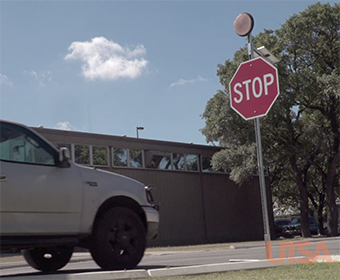(March 6, 2019) -- It’s dark on the backroad as a motorist speeds toward the intersection. Up ahead, the stop sign blends with the night and in seconds a deadly crash occurs. According to the U.S. Department of Transportation, more than half of all roadway fatalities occur on rural roads. Now engineers at The University of Texas at San Antonio (UTSA) are building and testing a low-cost, self-powered thermal system that will detect vehicles, improve the visibility of stop signs and prevent deaths.
“Stop signs on rural roads are difficult to notice, and this leads to dangerous accidents,” said Ayetullah Biten, a doctoral candidate in the UTSA Department of Electrical and Computer Engineering.
Rural roads account for 70 percent of the nation’s byways and the location for 54 percent of all fatalities, according to the Federal Highway Administration. Without access to a power supply, they are more likely than other roads to lack signals and active traffic signage.

To improve driver safety, Sara Ahmed and Samer Dessouky, professors in the UTSA College of Engineering, created a low-cost, self-powered intersection detection and warning system to alert rural motorists about potential dangers. The next-generation stop sign uses a multi-pixel passive infrared sensor that detects a vehicle as it approaches an intersection. Once the vehicle is within the sensing range, a signal beacon triggers the stop sign’s flashing system.
“The sensor observes thermal signatures and processes them to detect passing vehicles,” said Zachary Balcar, a master’s student in the UTSA Department of Electrical and Computer Engineering. “It distinguishes the vehicle’s direction of travel, estimates the velocity of its thermal signature and determines the classification of the vehicle.”
Overall, the smart system has a 90 percent vehicle detection rate and a vehicle classification accuracy of 72 percent. Compared to current traffic sensing technologies in urban areas such as magnetic loop inductors, video image processors and microwave radar, the new system consumes less power and offers better accuracy. The new technology is also much less expensive to produce. Current safety systems can cost as much as $5,000. UTSA’s detection promises to be a fraction of the price at $60 to $100 per unit.
“Our off-roadway system can be installed on urban or rural roads completely independent of the utility power grid, because it is powered by small solar panels and functions in all weather conditions,” said Ahmed.
>> Learn more about the low-powered sensing system.
The low-power rural intersection detection and warning system was developed with support from the Connect program, a collaborative research program that is co-funded by UTSA and Southwest Research Institute.
The project team has filed an invention disclosure for the system, which was recently recognized nationally by the American Road and Transportation Builders Association, and expects to adapt the technology to pedestrian detection, for border security and for vehicle-to-infrastructure communication.
Learn more about UTSA’s Electrical and Computer Engineering innovations.
Celebrate UTSA’s 50th Anniversary and share social media posts about the 50th using the hashtag #UTSA50.
Connect with UTSA online at Facebook, Twitter, YouTube, Instagram and LinkedIn.
UTSA Today is produced by University Communications and Marketing, the official news source of The University of Texas at San Antonio. Send your feedback to news@utsa.edu. Keep up-to-date on UTSA news by visiting UTSA Today. Connect with UTSA online at Facebook, Twitter, Youtube and Instagram.
Huddle Against Hunger is a fundraising competition with Texas State that benefits our Roadrunner Pantry. Donations this week will help UTSA earn additional prize monies provided by RBFCU.
In-Person and VirtualJoin UTSA Libraries for an update on federal public access policies and how the library can assist with compliance.
Virtual EventWe invite you to join us for Birds Up! Downtown, an exciting welcome back event designed to connect students with the different departments at the Downtown Campus. Students will have the opportunity to learn about some of the departments on campus, gain access to different resources, and collect some giveaways!
Bill Miller PlazaThere are many citation managers. Which one is right for you? This workshop will explain what a citation manager is and how it can help you organize your citations, insert citations as you write your paper, and generate your bibliography.
Virtual EventPubMed is an essential database for anyone conducting biomedical or health-related research. This workshop will teach attendees how to effectively navigate this free resource and locate peer-reviewed articles using advanced search features, MeSH subject headings, and Boolean operators.
Virtual EventIn this hands-on workshop, participants will learn to setup an EndNote library, save references and PDFs, and automatically create and edit a bibliography. Attendees are encouraged, but not required, to have EndNote already installed on a personal computer.
Virtual EventJoin UTSA Libraries and Museums to learn more about the publishing discounts available for UTSA researchers. Current agreements include Elsevier, Cambridge University Press, Wiley, and more. Bring your questions and feedback for the library as we continue to pursue partnerships with publishers to reduce costs for our researchers.
Virtual EventThe University of Texas at San Antonio is dedicated to the advancement of knowledge through research and discovery, teaching and learning, community engagement and public service. As an institution of access and excellence, UTSA embraces multicultural traditions and serves as a center for intellectual and creative resources as well as a catalyst for socioeconomic development and the commercialization of intellectual property - for Texas, the nation and the world.
To be a premier public research university, providing access to educational excellence and preparing citizen leaders for the global environment.
We encourage an environment of dialogue and discovery, where integrity, excellence, respect, collaboration and innovation are fostered.